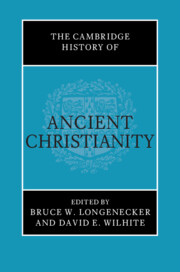Book contents
- The Cambridge History of Ancient Christianity
- The Cambridge History of Ancient Christianity
- Copyright page
- Contents
- Figures
- List of Contributors
- Editors’ Preface
- Part I Contested Contexts
- 1 The History of Ancient Christian History
- 2 The Present and Future of Ancient Christian History
- 3 Depicting the Other in Early Christian Polemic
- 4 Why Did People Become Christians in the Pre-Constantinian World?
- Part II Contested Figures
- Part III Contested Heritage
- Part IV Contested Cultures
- Part V Contested Beliefs
- Part VI Contested Bodies
- Ancient Sources
- Modern Authors
- References
4 - Why Did People Become Christians in the Pre-Constantinian World?
Reframing the Question
from Part I - Contested Contexts
Published online by Cambridge University Press: 23 August 2023
- The Cambridge History of Ancient Christianity
- The Cambridge History of Ancient Christianity
- Copyright page
- Contents
- Figures
- List of Contributors
- Editors’ Preface
- Part I Contested Contexts
- 1 The History of Ancient Christian History
- 2 The Present and Future of Ancient Christian History
- 3 Depicting the Other in Early Christian Polemic
- 4 Why Did People Become Christians in the Pre-Constantinian World?
- Part II Contested Figures
- Part III Contested Heritage
- Part IV Contested Cultures
- Part V Contested Beliefs
- Part VI Contested Bodies
- Ancient Sources
- Modern Authors
- References
Summary
The question contained in this chapter’s title continues to elicit many answers from academics, particularly in publications addressed to a larger audience.1 As has been observed by more than one scholar, however, the answers have not changed much since the time of Edward Gibbon (1737–94).2 Moreover, in my view the answers typically given are not fully convincing, so I take the opportunity here to reconsider the question – in fact, even to question the question. Instead of a critical review of the answers typically offered, I seek to deconstruct the question, using the words that compose the title of the chapter as a guide for uncovering the many assumptions that lay behind it. As a result, I will complicate the picture and illustrate the many ways that things can go wrong if fundamental assumptions embedded within the question are left unexposed, as is usually the case.
- Type
- Chapter
- Information
- The Cambridge History of Ancient Christianity , pp. 80 - 106Publisher: Cambridge University PressPrint publication year: 2023

